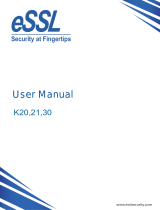
Using Administrative Console ............................................................................................................ 15
Configuring your system ..................................................................................................................... 16
Setting up authentication for your computer ...................................................................... 16
Logon Policy ...................................................................................................... 16
Session Policy ................................................................................................... 17
Settings .............................................................................................................................. 17
Managing users ................................................................................................................. 17
Credentials ......................................................................................................................... 17
SpareKey .......................................................................................................... 18
Fingerprints ....................................................................................................... 18
Face .................................................................................................................. 19
Smart card ......................................................................................................... 19
Initializing the smart card .................................................................. 19
Registering the smart card ............................................................... 20
Configuring the smart card ............................................................... 20
Contactless card ............................................................................................... 21
Proximity card ................................................................................................... 21
Bluetooth ........................................................................................................... 21
PIN .................................................................................................................... 21
Applications ........................................................................................................................................ 21
General tab ........................................................................................................................ 22
Applications tab ................................................................................................................. 22
Data .................................................................................................................................................... 22
Computer ............................................................................................................................................ 22
5 HP ProtectTools Security Manager ............................................................................................................. 23
Opening Security Manager ................................................................................................................. 23
Using the Security Manager User Console ........................................................................................ 23
Your personal ID card ........................................................................................................................ 24
My Logons .......................................................................................................................................... 24
Password Manager ............................................................................................................ 24
For Web pages or programs where a logon has not yet been created ............. 25
For Web pages or programs where a logon has already been created ............ 25
Adding logons ................................................................................................... 26
Editing logons .................................................................................................... 27
Using the Password Manager Quick Links menu ............................................. 27
Organizing logons into categories ..................................................................... 27
Managing your logons ....................................................................................... 28
Assessing your password strength ................................................................... 28
Password Manager icon settings ...................................................................... 29
Settings ............................................................................................................. 29
iv





















